Laying bituminous coating includes preparatory work, preparation of the base, heating of bitumen, uniform spreading, leveling of the surface, and rolling process, ensuring the stability, resistance and durability of the coating.
LAYING OF BITUMINOUS COATING
Bituminous roofing is one of the most popular and durable types of roofing used for residential and commercial roofing. The process of laying a bituminous coating includes several essential stages that must be carried out carefully to ensure a long-lasting and high-quality result. In this article, we will discuss in detail all stages of laying bituminous roofing, starting with preparatory work and ending with the final finishing layer.
During laying, it is important to use quality material and comply with technological requirements.
5 steps
bituminous roof laying
a) Preparation of the roof base
The first stage of bituminous roofing is the preparation of the roof base. It can be wooden boards, plywood or OSB boards. The surface must be clean, smooth and dry, without any irregularities or bumps. Any defects such as cracks or protrusions must be removed or smoothed out to ensure good adhesion of the bituminous coating. It is also important to make sure that the foundation of the roof is stable and strong, because the durability of the entire coating depends on it.
b) Laying of waterproofing material
Before starting to lay the bituminous coating, it is necessary to ensure that the roof is well waterproofed. As a rule, bituminous mastic or primer is used, which increases the adhesion of the bituminous coating to the base. The primer must be applied evenly, following the manufacturer's recommendations. It ensures that the bituminous coating will be firmly attached to the substrate and will not allow water to pass through.
a) Preparation of materials
Laying bituminous coating begins with the preparation of materials. Bituminous rolls or sheets must be unrolled and cut to the required dimensions. It is recommended to do this in advance in order to be able to work quickly and efficiently during laying. It is also important to take into account the weather conditions - it is ideal to lay bituminous coating in dry and warm weather, so that the material is more elastic and easier to form.
b) Laying technique
When laying the first layer, it is necessary to ensure that it is straight and evenly covered. The bituminous coating is laid from the bottom up, ensuring that each subsequent layer covers the previous one by a certain width, usually about 10 cm. This is important to ensure that water does not seep under the cover and cause leaks.
When laying a bituminous coating, it is necessary to pay attention to the connection points. The joints are the weakest places, so they need to be well pressed and, if necessary, additionally treated with bituminous mastic. In order to make the joints stronger, it is recommended to use heat treatment, for example, heating the joints with special gas burners. When the bituminous coating is heated, it becomes more elastic and adapts better to the shapes of the roof surface, thus ensuring a strong and tight connection.
c) Number of layers
The durability and reliability of the bituminous coating also depends on the number of laying layers. It is usually recommended to lay at least two layers - the main and the top. The main layer is thicker and stronger, it ensures the resistance of the roof to mechanical damage. The top layer, often with a UV protective coating, protects the roof from the sun and the weather.
a) Quality control
After the bituminous coating is finished, it is necessary to carry out a final inspection. Make sure that all connections are tight and there are no gaps or defects. If defects are found, they must be corrected immediately. It is also important to check that the entire coating is evenly coated and that there are no bumps or bends that could cause water to collect.
b) Protective coating
In order to further protect the bituminous coating, it is recommended to use an additional protective coating or paint. This coating protects the bituminous material from UV rays, which can eventually weaken its structure and cause cracks. The protective coating also helps maintain the aesthetic appearance of the roof and can be available in a variety of colors to match the design of the building.
c) Maintenance and operation
Maintenance of a bituminous roof covering is relatively simple, but it is important to carry out regular inspections of its condition. After severe storms or other extreme weather conditions, it is recommended to inspect the roof for damage or leaks. If any defects are noticed, they should be repaired immediately to prevent bigger problems in the future.
(a) Ecological benefits
Bituminous roofing is a relatively ecological material. Many manufacturers use recycled bitumen, which helps reduce waste and conserve natural resources. In addition, the bituminous coating is long-lasting, so it needs to be replaced less often, which also contributes to less waste.
b) Economic benefits
Bituminous roofing is competitively priced compared to other roofing materials. It is easily available and the installation process is not complicated, saving time and labor costs. In addition, due to its durability and resistance to various weather conditions, bituminous roofing requires less maintenance and repair, which also contributes to long-term economic utility.
Bituminous roofing technology is a reliable and long-lasting solution for various types of buildings. From proper roof base preparation and waterproofing to bituminous coating and final finishing, each step requires care and attention. By following all the recommendations and technical requirements, excellent results can be achieved, ensuring the roof's resistance and durability.






